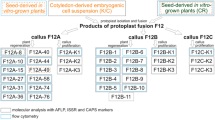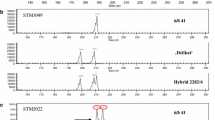Abstract
By applying polyethylene glycol (PEG)-mediated protoplast fusion, the first somatic hybrids were obtained between Cyclamen persicum (2n = 2x = 48) and C. coum (2n = 2x = 30)—two species that cannot be combined by cross breeding. Heterofusion was detected by double fluorescent staining with fluorescein diacetate and scopoletin. The highest heterofusion frequencies (of about 5%) resulted from a protocol using a protoplast density of 1 × 106/mL and 40% PEG. The DNA content of C. coum was estimated for the first time by propidium iodide staining to be 14.7 pg/2C and was 4.6 times higher than that of C. persicum. Among 200 in vitro plantlets regenerated from fusion experiments, most resembled the C. coum parent, whereas only 5 plants showed typical C. persicum phenotypes and 46 had a deviating morphology. By flow cytometry, six putative somatic hybrids were identified. A species-specific DNA marker was developed based on the sequence of the 5.8S gene in the ribosomal nuclear DNA and its flanking internal transcribed spacers ITS1 and ITS2. The hybrid status of only one plant could be verified by the species-specific DNA marker as well as sequencing of the amplification product. RAPD markers turned out to be less informative and applicable for hybrid identification, as no clear additivity of the parental marker bands was observed. Chromosome counting in root tips of four hybrids revealed the presence of the 30 C. coum chromosomes and 2–41 additional ones indicating elimination of C. persicum chromosomes.







Similar content being viewed by others
Abbreviations
- BA:
-
6-Benzyladenine
- 2iP:
-
6-(γ,γ-Dimethylallylamino)purine
- DAPI:
-
4′,6-Diamidino-2-phenylindol
- 2,4-D:
-
2,4-Dichlorophenoxyacetic acid
- FDA:
-
Fluorescein diacetate
- FISH:
-
Fluorescent in situ hybridisation
- GISH:
-
Genomic in situ hybridisation
- PEG:
-
Polyethylene glycol
- PGR:
-
Plant growth regulator
- RFLP:
-
Restriction fragment length polymorphism
- SSR:
-
Simple sequence repeat
References
Anderberg AA, Trift I, Kallersjö M (2000) Phylogeny of Cyclamen L. (Primulaceae): evidence from morphology and sequence data from the internal transcribed spacer of nuclear ribosomal DNA. Plant Syst Evol 220:147–160
Bennett MD, Price HJ, Johnston S (2008) Anthocyanin inhibits propidium iodide DNA fluorescence in Euphorbia pulcherrima: implications for genome size variation and flow cytometry. Ann Bot 101:777–790
Binding H, Nehls R (1978) Somatic cell hybridization of Vicia faba and Petunia hybrida. Mol Gen Genet 164:137–143
Binding H, Bunning D, Görschen E, Jörgensen J, Kollmann R, Krumbiegel-Schroeren G, Ling HQ, Monzer J, Mordhorst G, Rudnick J, Sauer A, Witt D, Zuba M (1988) Uniparental, fusant and chimeric plants regenerated from protoplasts after streak plating in agarose gels. Plant Cell Tiss Org Cult 12:133–135
Borchert T, Fuchs J, Winkelmann T, Hohe A (2007) Variable DNA content of Cyclamen persicum regenerated via somatic embryogenesis: rethinking the concept of long-term callus and suspension cultures. Plant Cell Tissue Org Cult 90:255–263
Cai X, Fu J, Chen C, Guo W (2009) Cybrid/hybrid plants regenerated from somatic fusions between male sterile Satsuma mandarin and seedy tangelos. Sci Hortic 122:323–327
Chen C, Grosser JW, Calovic M, Serrano P, Pasquali G, Gmitter J, Gmitter FG (2008) Verification of mandarin and pummelo somatic hybrids by expressed sequence tag—simple sequence repeat marker analysis. J Am Soc Hortic Sci 133:794–800
Cluster PD, Calderini O, Pupilli F, Crea F, Damiani F, Arcioni S (1996) The fate of ribosomal genes in three interspecific somatic hybrids of Medicago sativa: three different outcomes including the rapid amplification of new spacer-length variants. Theor Appl Genet 93:801–808
Cocking EC (1960) A method for the isolation of plant protoplasts and vacuoles. Nature 187:962–963
Dambier D, Benyahia H, Pensabene-Bellavia G, Kacar YA, Froelicher Y, Belfalah Z, Lhou B, Handaji N, Printz B, Morillon R, Yesiloglu T, Navarro L, Ollitrault P (2011) Somatic hybridization for citrus rootstock breeding: an effective tool to solve some important issues of the Mediterranean citrus industry. Plant Cell Rep 30:883–900
Dolezel J (1991) Flow cytometric analysis of nuclear DNA content in higher plants. Phytochem Anal 2:143–154
Dolezel J, Bartos J (2005) Plant DNA flow cytometry and estimation of nuclear genome size. Ann Bot 95:99–110
Dorey S, Kopp M, Geoffroy P, Fritig B, Kauffman S (1999) Hydrogen peroxide from the oxidative burst is neither necessary nor sufficient for hypersensitive cell death induction, phenylalanine ammonia lyase stimulation, salicylic acid accumulation, or scopoletin consumption in cultured tobacco cells treated with elicitin. Plant Physiol 121:163–171
Durieu P, Ochatt SJ (2000) Efficient intergeneric fusion of pea (Pisum sativum L.) and grass pea (Lathyrus sativus L.) protoplasts. J Exp Bot 51:1237–1242
Ewald A (1996) Interspecific hybridisation between Cyclamen persicum Mill. and C. purpurascens Mill. Plant Breed 115:162–166
Ewald A, Orlicz LA, Winkelmann T, Schwenkel HG (2000) Interspecific hybrids of Cyclamen persicum Mill. × Cyclamen purpurascens Mill.: propagation, somaclonal variation, resistance to Fusarium wilt and suitability as an outdoor crop. In: Proceedings of the 19th international symposium of improvement of ornamental plants genes, tools, Angers, France, 27–30 July 1998, vol 508, pp 309–310
Glasau F (1939) Monographie der Gattung Cyclamen auf morphologisch-cytologischer Grundlage (in German). Planta 30:507–550
Greilhuber J (2008) Cytochemistry and C-values: the less-well-known world of nuclear DNA amounts. Ann Bot 101:791–804
Grey-Wilson C (2003) Cyclamen: a guide for gardeners, new edn. Horticulturists and Botanists, Batsford, London
Grosser JW, Gmitter FG Jr (2011) Protoplast fusion for production of tetraploids and triploids: applications for scion and rootstock breeding in citrus. Plant Cell Tissue Org Cult 104:343–357
Hein T, Przewozny T, Schieder O (1983) Culture and selection of somatic hybrids using an auxotrophic cell line. Theor Appl Genet 64:119–122
Henfrey A, Moore T, Ayres WP (1852) The garden companion and florists guide. William S Orr and Co, Amen Corner, Paternoster Row, London, pp 89–90
Hillis DM, Dixon MT (1991) Ribosomal DNA: molecular evolution and phylogenetic inference. Q Rev Biol 66(4):411–453
Hothorn T, Bretz F, Westfall P (2008) Simultaneous inference in general parametric models. Biometric J 50:346–363
Ishizaka H (2008) Interspecific hybridisation by embryo rescue in the genus Cyclamen. Plant Biotech 25:511–519
Kanchanapoom K, Brightman AO, Grimes HD, Boss WF (1985) A novel method for monitoring protoplast fusion. Protoplasma 124:65–70
Kao KN (1975) A method for fusion of plant protoplasts with polyethylene glycol. In: Gamborg OL, Wetter LR (eds) Plant tissue culture methods. National Research Council of Canada, Prairie Regional Laboratory, Saskatoon, Canada, pp 22–27
Kao KN (1977) Chromosomal behaviour in somatic hybrids of soybean—Nicotiana glauca. Mol Gen Genet 150:225–230
Kao KN, Michayluk MR (1975) Nutritional requirements for growth of Vicia hajastana cells and protoplasts at a very low population density in liquid media. Planta 126:105–110
Kao KN, Constabel F, Michayluk MR, Gamborg OL (1974) Plant protoplast fusion and growth of intergeneric hybrid cells. Planta 120:215–227
Karp A, Nelson RS, Thomas E, Bright SWJ (1982) Chromosome variation in protoplast-derived potato plants. Theor Appl Genet 63:265–272
Mattheij WM, Puite KJ (1992) Tetraploid potato hybrids through protoplast fusions and analysis of their performance in the field. Theor Appl Genet 83:807–812
McClelland M, Welsh J (1990) Fingerprinting genomes using PCR with arbitrary primers. Nucleic Acids Res 18:7213–7218
McCullagh P, Nelder JA (1989) Generalized linear models, 2nd edn. Chapman & Hall, London
Meiners J, Debener T, Schweizer G, Winkelmann T (2011) Analysis of the taxonomic subdivision within the genus Helleborus by nuclear DNA content and genome-wide DNA markers. Sci Hortic 128:38–47
Menczel L, Wolfe K (1984) High frequency of fusion induced in freely suspended protoplast mixtures by polyethylene glycol and dimethylsulfoxide at high pH. Plant Cell Rep 3:196–198
Meyer L, Serek M, Winkelmann T (2009) Protoplast isolation and plant regeneration of different genotypes of Petunia and Calibrachoa. Plant Cell Tissue Organ Cult 99:27–34
Prange ANS, Serek M, Bartsch M, Winkelmann T (2010) Efficient and stable regeneration from protoplasts of Cyclamen coum Miller via somatic embryogenesis. Plant Cell Tissue Org Cult 101:171–182
R Development Core Team (2008) R: a language and environment for statistical computing. R foundation for statistical computing, Vienna, Austria. ISBN 3-900051-07-0. http://www.R-project.org
Rasmussen JO, Waara S, Rasmussen OS (1997) Regeneration and analysis of interspecific asymmetric potato—Solanum ssp. hybrid plants selected by micromanipulation or fluorescence-activated cell sorting (FACS). Theor Appl Genet 95:41–49
Schwenkel HG, Winkelmann T (1998) Plant regeneration via somatic embryogenesis from ovules of Cyclamen persicum Mill. Plant Tissue Cult Biotechnol 4(1):28–34
Taguchi G, Fujikawa S, Yazawa T, Kodaira R, Hayashida N, Shimosaka M, Okazaki M (2000) Scopoletin uptake from culture medium and accumulation in the vacuoles after conversion to scopolin in 2, 4-D-treated tobacco cells. Plant Sci 151:153–161
Waara S, Nyman M, Johannisson A (1998) Efficient selection of potato heterokaryons by flow cytometric sorting and the regeneration of hybrid plants. Euphytica 101:293–299
Wetter LR, Kao KN (1980) Chromosome and isoenzyme studies on cells derived from protoplast fusion of Nicotiana glauca with Glycine max–Nicotiana glauca cell hybrids. Theor Appl Genet 57:273–276
Williams JGK, Kubelik AR, Livak KJ, Rafalski JA, Tingey SV (1990) DNA polymorphisms amplified by arbitrary primers are useful as genetic markers. Nucleic Acids Res 18(22):6531–6535
Winkelmann T, Grunewaldt J (1995) Genotypic variability for protoplast regeneration in Saintpaulia ionantha (H. Wendl.). Plant Cell Rep 14:704–707
Winkelmann T, Hohe A, Schwenkel HG (1998) Establishing embryogenic suspension cultures in Cyclamen persicum ‘Purple Flamed’. Adv Hortic Sci 12:25–30
Winkelmann T, Specht J, Serek M (2006) Efficient plant regeneration from protoplasts isolated from embryogenic suspension cultures of Cyclamen persicum Mill. Plant Cell Tissue Org Cult 86:337–347
Winkelmann T, Prange ANS, Specht J, Serek M (2008) Morphological characterization of plants regenerated from protoplasts of Cyclamen persicum Mill. Prop Ornam Plants 8:9–12
Yao MC, Gall JG (1977) A single integrated gene for ribosomal RNA in a eucaryote, Tetrahymena pyriformis. Cell 12:121–132
Yarrow SA, Wu SC, Barsby TL, Kemble RJ, Shepard JF (1986) The introduction of CMS mitochondria to triazine tolerant Brassica napus L., var. ‘Regent’, by micromanipulation of individual heterokaryons. Plant Cell Rep 5:415–418
Acknowledgments
The authors thank Dr. Frank Schaarschmidt for his help in statistical data analysis, Ulrich Lohmueller for the determination of the absolute DNA content of hybrid no. 31 and Dr. Joerg Fuchs (IPK Gatersleben) for the donation of the Vicia faba, Pisum sativum and the Secale cereale seeds. Financial support of the German Federal Ministry of Economics and Technology within the program PRO INNO Grant no. KF0054802MD5 is gratefully acknowledged.
Author information
Authors and Affiliations
Corresponding author
Additional information
Communicated by R. Rose.
Electronic supplementary material
Below is the link to the electronic supplementary material.
Rights and permissions
About this article
Cite this article
Prange, A.N.S., Bartsch, M., Meiners, J. et al. Interspecific somatic hybrids between Cyclamen persicum and C. coum, two sexually incompatible species. Plant Cell Rep 31, 723–735 (2012). https://doi.org/10.1007/s00299-011-1190-z
Received:
Revised:
Accepted:
Published:
Issue Date:
DOI: https://doi.org/10.1007/s00299-011-1190-z




